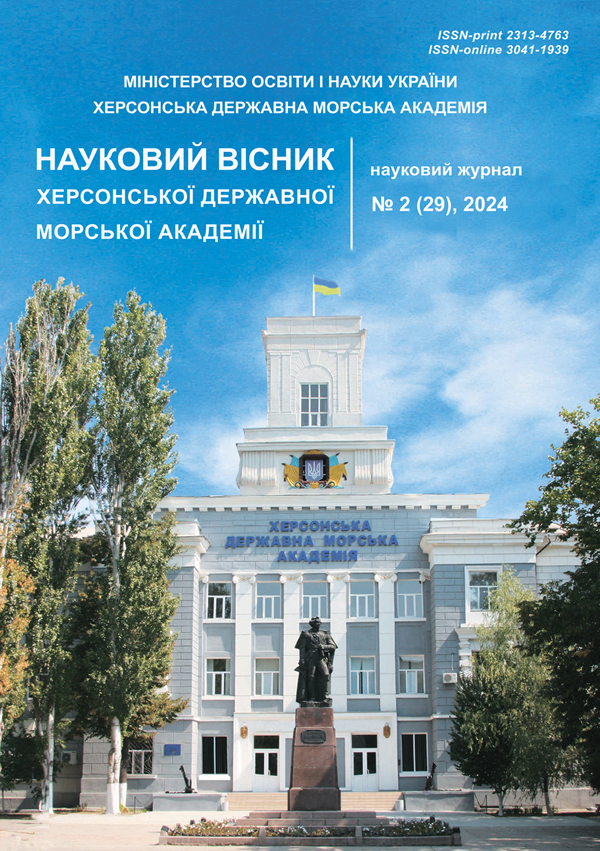DECISION-MAKING METHODS FOR SHIP TRAFFIC CONTROL IN INTELLIGENT NAVIGATION INFORMATION SYSTEMS
https://doi.org/10.33815/2313-4763.2024.2.29.099-110
Abstract
The article is devoted to issues of development of decision-making support methods in the field of navigation and their practical application in intelligent navigation information systems (INIS). An analysis of the accident rate of modern world shipping over the past two decades was carried out, its dynamics were determined, and the main factors of the occurrence of accidents were clarified. It has been proven that the dominant share of accidents is due to the negative influence of the human factor on the processes of ship control, which, as a result, leads to collisions, groundings, as well as to the occurrence of dangerous situations on ships and failures in the operation of its systems. The types of errors caused by human influence on ship control processes are shown and possible ways to reduce their number are proposed. The role and place of INIS and decision-making support systems (DSS) in solving the problems of improving the quality and efficiency of ship and ship systems control processes with the aim of reducing the level of accidents have been determined. It has been proven that INIS have a significant potential in solving the problems of reducing the number of errors caused by the influence of human factor on processes of controlling ships and auxiliary systems, and, as a result, will contribute to reducing the number of accidents in world shipping. The growing role of modern information technologies, in particular the methods of artificial intelligence and intelligent data analysis, in the solved issues of improving the safety of modern shipping, increasing the level of its automation, is shown. The classification of decision-making methods in the field of shipping by classes of problems to be solved is proposed. Features of the practical application of each group of methods in INIS are determined, and promising ways of their further development are outlined. The general structure of INIS was developed, and the application of a four-stage cycle was proposed for the implementation of the decision-making process with the differentiated use of different groups of methods and sources of initial data at each of the stages. The priority ways and prospects for the further application of DSS and INIS in navigation, as well as their place and role in development of the industry of unmanned and autonomous sea vessels, have been determined.
References
2. Vahushchenko, L. L. (2016). Sudnovi navihatsiino-informatsiini systemy. Odesa : NU «OMA», 238 c.
3. Ben, A. P. (2024). Systemy pidtrymky pryiniattia rishen v sudnovodinni: suchasnyi stan ta perspektyvy podalshoho rozvytku. Naukovyi visnyk Khersonskoi derzhavnoi morskoi akademii. № 1 (28). S. 152–162.
4. Aylward, K., Weber, R., Lundh, M., MacKinnon, S. N., Dahlman, J. (2022). Navigators’ views of a collision avoidance decision support system for maritime navigation. The Journal of Navigation 75: 5. 1035–1048.
5. Ben A. P. (2012). Perspektyvy rozvytku system pidtrymky pryiniattia rishen sudnovodiia / Ben A. P. // Naukovyi visnyk Khersonskoi derzhavnoi morskoi akademii. – Kherson : Vydavnytstvo KhDMA. № 1 (6). S. 12–19.
6. Iakusevych, Yu. H., Tryshyn, V. V., Dorofieieva, Z. Ya. (2021). Pobudova navihatsiinoi systemy sudna na osnovi suchasnykh informatsiinykh tekhnolohii. Kibernetyka ta systemnyi analiz. №4(70). C. 83–88.
7. Ben, A. P., Maltsev, A. S. (2019). Systemy pidtrymky pryiniattia rishen shchodo upravlinnia rukhom sudna // Monohrafiia. Kherson : Vydavnytstvo KhDMA. 244 s.
8. Pietrzykowski, Z., Wołejsza, P., Borkowski, P. (2017). Decision support in collision situations at sea. J. Navig. Vol. 70. P. 447–464.
9. Abudu, R., Bridgelall, R. (2024). Autonomous Ships: A Thematic Review. World 2024, 5, Р. 276–292.
10. Yan, X., Li, C., Liu, J., You, X., Wang, S., Ma, F. (2021). Architecture and key technologies for new generation of waterborne transportation system. Journal of Transportation Systems Engineering and Information Technology, 21(5):22.
11. Krata, P., Kniat, A., Vettor, R., Krata, H., Guedes Soares, C. (2021). The Development of a Combined Method to Quickly Assess Ship Speed and Fuel Consumption at Different Powertrain Load and Sea Conditions. TransNav, the International Journal on Marine Navigation and Safety of Sea Transportation. Vol. 15, № 2. Р. 437–444.
12. Sang Jin Kim, Mihkel Kõrgersaar, Nima Ahmadi, Ghalib Taimuri, Pentti Kujala, Spyros Hirdaris (2021). The influence of fluid structure interaction modelling on the dynamic response of ships subject to collision and grounding, Marine Structures, Vol. 75, 102875.
13. Dugan, S. A., Skjetne, R., Wróbel, K., Montewka, J., Gil, M., Utne, I. B. (2023). Integration Test Procedures for a Collision Avoidance Decision Support System Using STPA. TransNav, the International Journal on Marine Navigation and Safety of Sea Transportation. Vol. 17, № 2. Р. 375–381.
14. MacKinnon, S. N., Weber, R., Olindersson, F. and Lundh, M. (2020). Artificial Intelligence in Maritime Navigation: A Human Factors Perspective/In book: Advances in Human Aspects of Transportation, N. Stanton (Ed.): AHFE 2020, AISC 1212, pp. 429–435.
15. Zhang, M. (2023). Big data analytics methods for collision and grounding risk analysis in real conditions: framework, evaluation, and applications. Aalto University; Doctoral thesis, 202 р.
16. Du, L, Goerlandt, F, Kujala, P. (2020). Review and analysis of methods for assessing maritime waterway risk based on non-accident critical events detected from AIS data. Reliability Engineering and System Safety, 200, 106933.
17. Huang, Y., Chen, L., Chen, P., Negenborn, R. R., Van Gelder PHAJM (2020). Ship collision avoidance methods: state-of-the-art. Safety Science, 121, Р. 451–473.
18. Li, Y., Song, G., Yip, T.-L., Yeo, G.-T. (2024). Fuzzy Logic-Based Decision-Making Method for Ultra-Large Ship Berthing Using Pilotage Data J. Mar. Sci. Eng. 12, 717.
19. Tunçel, A. L., Yüksekyıldız, E., Akyuz, E., & Arslan, O. (2021). Probability-based extensive quantitative risk analysis: collision and grounding case studies for bulk carrier and general cargo ships. Australian Journal of Maritime & Ocean Affairs. 15(1), 89–105.
20. Başhan, V., Demirel, H. & Gul, M. (2020). An FMEA-based TOPSIS approach under single valued neutrosophic sets for maritime risk evaluation: the case of ship navigation safety. Soft Computing, 24, 18749–18764.
21. Bünyamin Kamal, Erkan Çakır (2022). Data-driven Bayes approach on marine accidents occurring in Istanbul strait, Applied Ocean Research, Volume 123, 103180.
22. Axel Hörteborn, Jonas, W. Ringsberg (2021). A method for risk analysis of ship collisions with stationary infrastructure using AIS data and a ship manoeuvring simulator, Ocean Engineering, Volume 235, 109396.
23. Leveson, N. G. (2016). Engineering a safer world: systems thinking applied to safety. The MIT Press. p. 560.
24. Kujala, P., Hänninen, M., Arola, T., Ylitalo, J. (2009). Analysis of the marine traffic safety in the Gulf of Finland, Reliability Engineering & System Safety, Vol. 94, Issue 8, pp. 1349–1357.
25. https://lloydslist.maritimeintelligence.informa.com/sectors/casualty.
26. Wu, B., Yip, T. L., Yan, X., Soares, C. G. (2022). Review of techniques and challenges of human and organizational factors analysis in maritime transportation. Reliability Engineering and System Safety, 219:108249.
27. IMO (2002). Guidelines for formal safety assessment (FSA) for use in the imo rule-making process. London, UK: International Maritime Organization – MSC/Circ.1023-MEPC/Circ.392.
28. ISO (2018). ISO 31000:2018. Risk management – guidelines. International Organization for Standardization.
29. IMO (1972). Convention on the international regulations for preventing collisions at Sea, 1972 (COLREGs).
30. IMO (2024). Maritime safety committee POLARIS – proposed system for determining operational limitations in ice. In: Submitted by the International Association of Classification Societies, MSC 94/3/7,9th Session, Agenda 3, September 12; 2014.
31. IMO (2021). Outcome of the regulatory scoping exercise for the use of maritime autonomous surface ships (MASS) – MSC.1-Circ.1638, London, UK.






